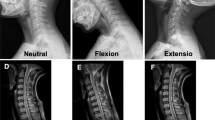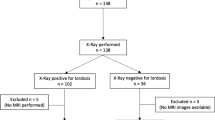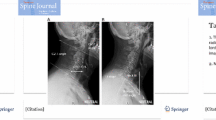Abstract
Purpose
To test the reliability and validity of the multi-positional magnetic resonance imaging (MRI) in measuring cervical angular parameter using the standard dynamic cervical X-ray as a reference.
Methods
All patients who underwent both cervical dynamic plain radiograph and multi-positional MRI on the same day between 2010 and 2016 were included in this study. The C2–7 angle and the segmental angles of the C2–3 to C6–7 segments were measured in all three positions (neutral, flexion, and extension) using multi-positional MRI and dynamic radiograph. The Pearson’s correlation coefficients and linear regression analysis were used for statistical analysis.
Results
46 patients were enrolled in this study. All angular parameters showed significant positive correlation between multi-positional MRI and dynamic X-ray (p < 0.05). The angle of C2–7 showed significantly positive correlation between multi-positional MRI and X-ray (r = 0.552–0.756). All segmental angles from C2–3 to C6–7 showed moderate correlation (r = 0.401–0.636). The linear regression analysis showed that C2–7 angles and all angular parameters had significant correlation between multi-positional MRI and dynamic X-ray (p < 0.05, R 2 = 0.107–0.571).
Conclusions
The C2–7 angle and segmental cervical angles measured by multi-positional MRI were valid, and reliability substituted the dynamic X-ray measurement within the acceptable range of error. Multi-positional MRI can be used as a reliable tool for angular parameter measurement and detection of angular instability in the cervical spine.


Similar content being viewed by others
References
Harris MB, Kronlage SC, Carboni PA, Robert KQ, Menmuir B, Ricciardi JE, Chutkan NB (2000) Evaluation of the cervical spine in the polytrauma patient. Spine (Phila Pa 1976) 25(22):2884–2891 (discussion 2892)
Dvorak J, Panjabi MM, Grob D, Novotny JE, Antinnes JA (1993) Clinical validation of functional flexion/extension radiographs of the cervical spine. Spine (Phila Pa 1976) 18(1):120–127
Bone CM, Hsieh GH (2000) The risk of carcinogenesis from radiographs to pediatric orthopaedic patients. J Pediatr Orthop 20(2):251–254
Lee MC, Solomito M, Patel A (2013) Supine magnetic resonance imaging Cobb measurements for idiopathic scoliosis are linearly related to measurements from standing plain radiographs. Spine (Phila Pa 1976) 38(11):E656–E661. doi:10.1097/BRS.0b013e31828d255d
Lord EL, Alobaidan R, Takahashi S, Cohen JR, Wang CJ, Wang BJ, Wang JC (2014) Kinetic magnetic resonance imaging of the cervical spine: a review of the literature. Glob Spine J 4(2):121–128. doi:10.1055/s-0034-1375563
Muhle C, Metzner J, Weinert D, Schon R, Rautenberg E, Falliner A, Brinkmann G, Mehdorn HM, Heller M, Resnick D (1999) Kinematic MR imaging in surgical management of cervical disc disease, spondylosis and spondylotic myelopathy. Acta Radiol 40(2):146–153
Miyazaki M, Hong SW, Yoon SH, Zou J, Tow B, Alanay A, Abitbol JJ, Wang JC (2008) Kinematic analysis of the relationship between the grade of disc degeneration and motion unit of the cervical spine. Spine (Phila Pa 1976) 33(2):187–193. doi:10.1097/BRS.0b013e3181604501
Miyazaki M, Hymanson HJ, Morishita Y, He W, Zhang H, Wu G, Kong MH, Tsumura H, Wang JC (2008) Kinematic analysis of the relationship between sagittal alignment and disc degeneration in the cervical spine. Spine (Phila Pa 1976) 33(23):E870–E876. doi:10.1097/BRS.0b013e3181839733
Morishita Y, Naito M, Hymanson H, Miyazaki M, Wu G, Wang JC (2009) The relationship between the cervical spinal canal diameter and the pathological changes in the cervical spine. Eur Spine J 18(6):877–883. doi:10.1007/s00586-009-0968-y
Evans JD (1996) Straightforward statistics for the behavioral sciences. Brooks/Cole Pub. Co., Pacific Grove
Griffiths HJ, Wagner J, Anglen J, Bunn P, Metzler M (2002) The use of forced flexion/extension views in the obtunded trauma patient. Skelet Radiol 31(10):587–591. doi:10.1007/s00256-002-0545-5
Khan SN, Erickson G, Sena MJ, Gupta MC (2011) Use of flexion and extension radiographs of the cervical spine to rule out acute instability in patients with negative computed tomography scans. J Orthop Trauma 25(1):51–56. doi:10.1097/BOT.0b013e3181dc54bf
Sierink JC, van Lieshout WA, Beenen LF, Schep NW, Vandertop WP, Goslings JC (2013) Systematic review of flexion/extension radiography of the cervical spine in trauma patients. Eur J Radiol 82(6):974–981. doi:10.1016/j.ejrad.2013.02.009
Ruegg TB, Wicki AG, Aebli N, Wisianowsky C, Krebs J (2015) The diagnostic value of magnetic resonance imaging measurements for assessing cervical spinal canal stenosis. J Neurosurg Spine 22(3):230–236. doi:10.3171/2014.10.SPINE14346
Kristjansson E, Leivseth G, Brinckmann P, Frobin W (2003) Increased sagittal plane segmental motion in the lower cervical spine in women with chronic whiplash-associated disorders, grades I-II: a case-control study using a new measurement protocol. Spine (Phila Pa 1976) 28(19):2215–2221. doi:10.1097/01.BRS.0000089525.59684.49
Dvorak J, Antinnes JA, Panjabi M, Loustalot D, Bonomo M (1992) Age and gender related normal motion of the cervical spine. Spine (Phila Pa 1976) 17(10 Suppl):S393–S398
Buonocore E, Hartman JT, Nelson CL (1966) Cineradiograms of cervical spine in diagnosis of soft-tissue injuries. JAMA 198(1):143–147
Dimnet J, Pasquet A, Krag MH, Panjabi MM (1982) Cervical spine motion in the sagittal plane: kinematic and geometric parameters. J Biomech 15(12):959–969
Davis JW, Kaups KL, Cunningham MA, Parks SN, Nowak TP, Bilello JF, Williams JL (2001) Routine evaluation of the cervical spine in head-injured patients with dynamic fluoroscopy: a reappraisal. J Trauma 50(6):1044–1047
Acknowledgements
This work was funded by departmental funds. The authors would like to thank AiM Radiology Medical Group, especially to Yusuf A. Khan, Sameer U. Khan and Aziza Qadir MD for their help on obtaining and uploading kMRI images into the database.
Author information
Authors and Affiliations
Corresponding author
Ethics declarations
Conflict of interest
All authors declare that they have no conflict of interest. Disclosures: ZB-Xenco Medical (consultancy), AO Spine (consultancy, past); JCW–Royalties: Aesculap, Biomet, Amedica, Seaspine, Synthes; Stock Ownership: Fziomed; Private Investments: Promethean Spine, Paradigm spine, Benevenue, NexGen, Vertiflex, ElectroCore, Surgitech, Expanding Orthopaedics, Osprey, Bone Biologics, Curative Biosciences, PearlDiver; Board of Directors: North American Spine Society (Second Vice President), North American Spine Foundation (non-financial), Cervical Spine Research Society (Travel expenses), AO Spine/AO Foundation (honorariums for board position); Fellowship Support: AO Foundation (spine fellowship funding paid to institution).
Rights and permissions
About this article
Cite this article
Paholpak, P., Tamai, K., Shoell, K. et al. Can multi-positional magnetic resonance imaging be used to evaluate angular parameters in cervical spine? A comparison of multi-positional MRI to dynamic plain radiograph. Eur Spine J 27, 1021–1027 (2018). https://doi.org/10.1007/s00586-017-5306-1
Received:
Revised:
Accepted:
Published:
Issue Date:
DOI: https://doi.org/10.1007/s00586-017-5306-1




